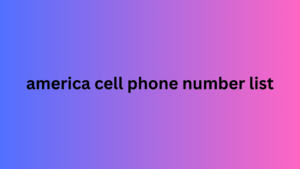Search engine optimization (SEO) has evolved significantly, and one of the key components of a successful SEO strategy is effective anchor text usage. This is especially true when targeting long-tail keywords, which can drive highly relevant traffic. This article delves into advanced anchor text strategies to help you rank higher for long-tail keywords.
1. Understanding the Importance of Anchor Text for Long-Tail Keywords
Anchor text is the clickable text in a hyperlink. When optimized correctly, it provides context to search engines about the content being linked. For long-tail keywords—phrases with three or more words that are specific and less competitive—anchor text plays a pivotal role in signaling relevance.
Using long-tail keywords in your anchor text can help you rank for niche queries that your audience is searching for. These keywords have lower competition and higher conversion rates america cell phone number list, making them a valuable target for businesses looking to attract qualified leads.
2. Diversifying Anchor Text Types
A common mistake is over-optimizing anchor text by repeatedly using the same long-tail keyword. This can trigger search engine penalties. To avoid this, use a mix of the following anchor text types:
- Exact match: Incorporate the exact long-tail keyword (e.g., “best running shoes for women”) sparingly.
- Partial match: Include variations of the keyword (e.g., “find the best shoes for running”) to maintain a natural flow.
- Branded: Use your brand name (e.g., “Nike shoes”) to build brand authority.
- Generic: Use phrases like “click here” or “learn more” to vary your profile.
- Naked URLs: Simply use the URL for diversity.
3. Contextual Relevance is Key
The placement of your anchor text matters. Ensure the surrounding content is highly relevant to the long-tail keyword being targeted. For instance how to choose the best anchor text for long-tail keyword targeting, if your anchor text is “affordable digital marketing tools”, the linking content should discuss digital marketing tools in detail.
Search engines use context to evaluate link quality. High-quality content around your anchor text improves its effectiveness and helps your page rank for the desired keyword.
4. Leverage Internal and External Links Wisely
Both internal and external links contribute to anchor text optimization.
- Internal links: Use descriptive anchor texts to guide users to related pages within your website. For instance, link from a blog post about SEO basics to a detailed guide on “how to optimize for long-tail keywords.”
- External links: When linking to authoritative sources de cell number, ensure the anchor text complements the content and maintains relevance. This builds credibility for your page while supporting your SEO goals.
Avoid overloading your content with links, as this can dilute their value. Focus on quality over quantity to maintain a strong link profile.

